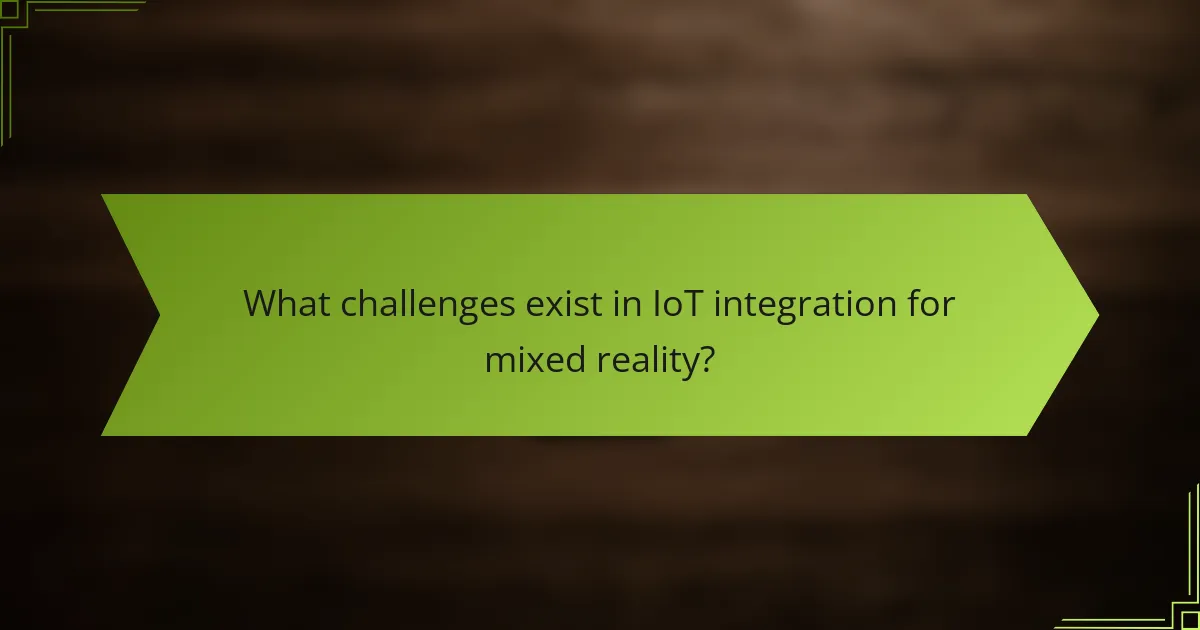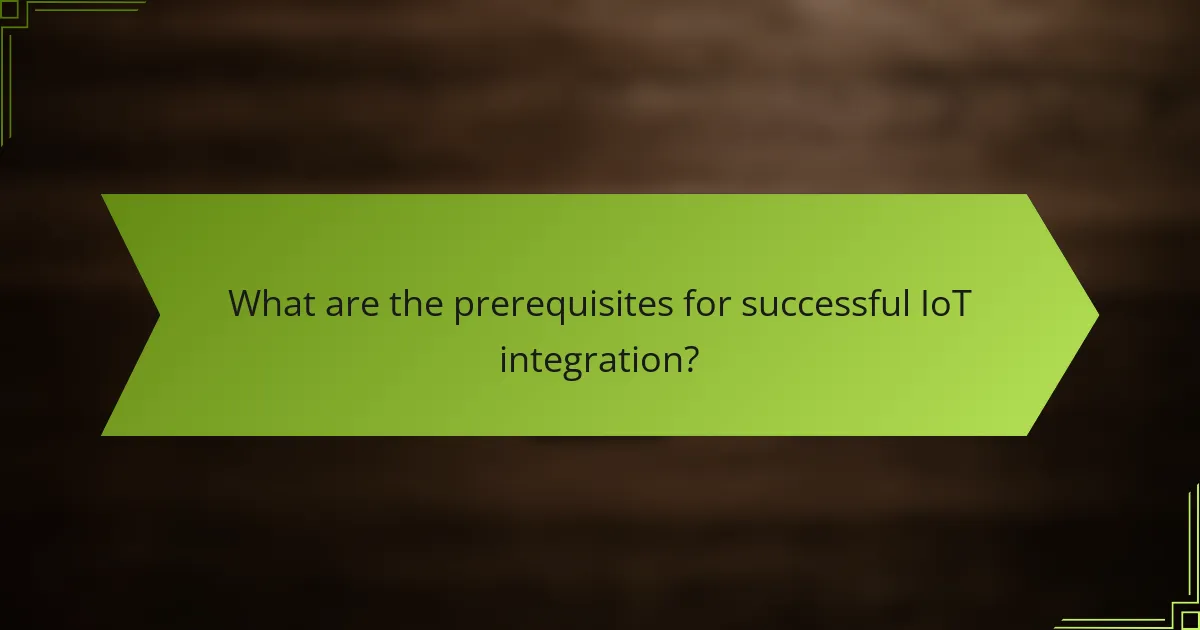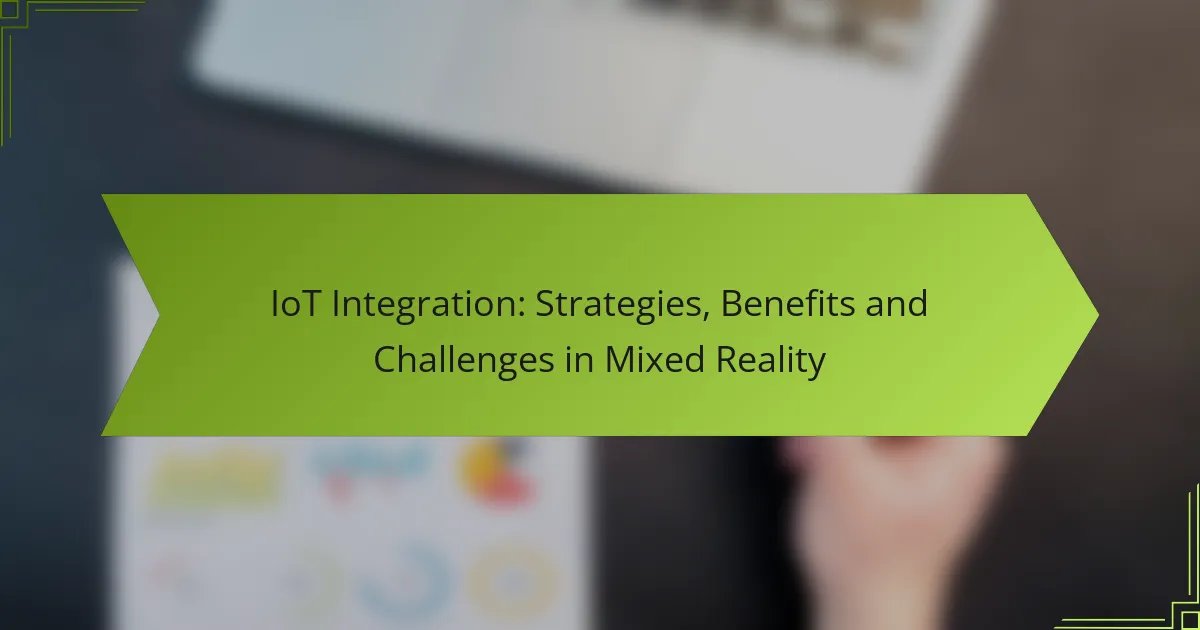The integration of IoT in mixed reality presents a transformative opportunity to enhance user engagement and operational efficiency by merging real-time data with immersive environments. Key strategies such as leveraging edge computing and cloud-based platforms can optimize these applications, while also addressing challenges like security vulnerabilities and system complexity. Understanding both the benefits and obstacles is essential for successful implementation across various sectors.

What are the key strategies for IoT integration in mixed reality?
Key strategies for integrating IoT in mixed reality include leveraging edge computing, utilizing cloud-based platforms, ensuring interoperability, and applying data analytics. These approaches enhance the efficiency and effectiveness of IoT applications within mixed reality environments.
Edge computing for real-time data processing
Edge computing allows data to be processed closer to the source, reducing latency and improving response times in mixed reality applications. This is crucial for scenarios where real-time interaction is necessary, such as in augmented reality gaming or industrial training simulations.
Implementing edge computing involves deploying local servers or devices that can handle data processing tasks. This setup can minimize the need for constant cloud communication, which is beneficial in environments with limited connectivity.
Cloud-based IoT platforms for scalability
Cloud-based IoT platforms provide the scalability needed to manage large volumes of data generated by mixed reality applications. These platforms enable seamless integration of various IoT devices and facilitate data storage and processing without the constraints of local infrastructure.
When selecting a cloud platform, consider factors such as pricing models, data security, and the ability to support multiple device types. Popular platforms often offer tiered pricing, allowing businesses to scale their usage according to demand.
Interoperability standards for device communication
Interoperability standards are essential for ensuring that different IoT devices can communicate effectively within mixed reality environments. Standards like MQTT and CoAP facilitate smooth data exchange and integration across diverse systems.
Adopting these standards can help avoid vendor lock-in and enhance the flexibility of IoT deployments. Businesses should prioritize devices that comply with widely accepted interoperability standards to ensure compatibility and ease of integration.
Data analytics for actionable insights
Data analytics plays a critical role in extracting actionable insights from the vast amounts of data generated by IoT devices in mixed reality. By analyzing this data, organizations can make informed decisions that enhance user experiences and operational efficiency.
Utilizing analytics tools can help identify patterns and trends, allowing businesses to optimize their mixed reality applications. Consider employing machine learning algorithms to predict user behavior and improve system responsiveness based on real-time data analysis.

What are the benefits of IoT integration in mixed reality?
IoT integration in mixed reality enhances user engagement and operational efficiency by combining real-time data with immersive environments. This synergy allows for more informed decision-making and improved productivity across various sectors.
Enhanced user experience through immersive environments
Integrating IoT with mixed reality creates immersive environments that significantly enhance user experience. For instance, in retail, customers can visualize products in their own space using augmented reality, leading to higher satisfaction and potentially increased sales.
Moreover, training programs utilizing mixed reality can simulate real-world scenarios, allowing users to practice skills in a safe yet realistic setting. This hands-on approach can lead to better retention of information and skills.
Improved operational efficiency and productivity
IoT integration streamlines operations by providing real-time insights into processes and equipment. For example, in manufacturing, sensors can monitor machinery performance, alerting operators to maintenance needs before breakdowns occur, thus minimizing downtime.
Additionally, mixed reality can facilitate remote collaboration, allowing teams to work together in a virtual space. This reduces travel costs and time, leading to enhanced productivity and faster project completion.
Real-time data visualization for informed decision-making
Real-time data visualization is a key benefit of IoT in mixed reality, enabling users to interact with complex data sets intuitively. Dashboards in mixed reality can display critical metrics in an engaging manner, helping stakeholders make quicker, data-driven decisions.
For instance, in healthcare, doctors can visualize patient data in 3D, providing a clearer understanding of conditions and treatment options. This immediate access to information can lead to improved patient outcomes and more effective care strategies.

What challenges exist in IoT integration for mixed reality?
IoT integration for mixed reality faces several significant challenges, including security vulnerabilities, system complexity, and high costs. Addressing these issues is crucial for successful implementation and user acceptance.
Security vulnerabilities in connected devices
Security vulnerabilities are a major concern in IoT integration for mixed reality. Connected devices can be susceptible to hacking, data breaches, and unauthorized access, which can compromise user privacy and system integrity. Ensuring robust security measures, such as encryption and regular software updates, is essential.
Organizations should adopt a multi-layered security approach, including firewalls, intrusion detection systems, and secure authentication methods. Regular security audits can help identify and mitigate potential risks before they become critical issues.
Complexity of system integration
The complexity of integrating various IoT devices into mixed reality systems can pose significant challenges. Different devices may use incompatible protocols, leading to difficulties in communication and data exchange. This complexity can hinder the seamless user experience that mixed reality aims to provide.
To manage this complexity, organizations should focus on standardization and interoperability. Utilizing common communication protocols, such as MQTT or CoAP, can simplify integration and enhance device compatibility. Additionally, investing in middleware solutions can help bridge gaps between disparate systems.
High costs of implementation and maintenance
High costs associated with the implementation and maintenance of IoT systems in mixed reality can deter organizations from pursuing these technologies. Initial investments in hardware, software, and skilled personnel can be substantial, often reaching thousands of dollars depending on the scale of deployment.
To mitigate costs, organizations can explore phased implementation strategies, starting with pilot projects to validate concepts before full-scale deployment. Additionally, leveraging cloud-based solutions can reduce the need for extensive on-premises infrastructure, lowering both initial and ongoing expenses.

How does IoT integration impact industries in major urban areas?
IoT integration significantly enhances operational efficiency and service delivery in industries located in major urban areas. By connecting devices and systems, businesses can gather real-time data, optimize processes, and improve customer experiences.
Smart cities enhancing public services
Smart cities leverage IoT to improve public services such as transportation, waste management, and energy distribution. For instance, smart traffic lights can adjust their timing based on real-time traffic data, reducing congestion and travel times.
Additionally, waste management systems equipped with sensors can notify city services when bins are full, optimizing collection routes and saving costs. Urban areas that adopt these technologies often see enhanced service delivery and reduced operational expenses.
Retail environments optimizing customer engagement
In retail, IoT integration allows businesses to create personalized shopping experiences. Smart shelves equipped with sensors can track inventory levels and notify staff when items need restocking, ensuring customers find what they need.
Moreover, retailers can use data from connected devices to analyze customer behavior and preferences. This information can inform targeted marketing campaigns, improving customer engagement and potentially increasing sales by tens of percent.

What are the prerequisites for successful IoT integration?
Successful IoT integration requires a combination of robust infrastructure and a skilled workforce. These elements ensure that devices can communicate effectively and that the technology is managed efficiently.
Robust infrastructure for connectivity
A strong infrastructure is essential for seamless connectivity in IoT systems. This includes reliable internet access, sufficient bandwidth, and low-latency networks to support real-time data transmission. Organizations should consider investing in technologies like 5G or dedicated IoT networks to enhance connectivity.
Additionally, implementing edge computing can reduce latency by processing data closer to the source. This setup minimizes delays and optimizes performance, particularly in applications requiring immediate responses, such as smart manufacturing or healthcare monitoring.
Skilled workforce for technology management
Having a skilled workforce is critical for managing IoT technologies effectively. Employees should be trained in data analytics, cybersecurity, and device management to ensure that IoT systems operate smoothly and securely. Organizations may consider offering ongoing training programs or partnerships with educational institutions to develop these skills.
Moreover, fostering a culture of innovation can encourage employees to explore new IoT applications and solutions. This proactive approach can lead to improved efficiency and the ability to adapt to evolving technology trends, ultimately enhancing the organization’s competitive edge.

How to choose the right IoT solutions for mixed reality?
Selecting the appropriate IoT solutions for mixed reality involves assessing compatibility, scalability, and the specific needs of your application. Focus on solutions that integrate seamlessly with your existing systems and provide robust support for real-time data processing and visualization.
Evaluating vendor capabilities and support
When evaluating IoT vendors for mixed reality, consider their technical expertise and the level of support they offer. Look for vendors with a proven track record in IoT and mixed reality solutions, as well as those that provide comprehensive documentation and customer service.
Assess the vendor’s ability to integrate with your current infrastructure. This includes checking for compatibility with existing hardware and software, as well as their responsiveness to updates and troubleshooting. A reliable vendor should offer ongoing support and regular updates to ensure optimal performance.
Additionally, consider the vendor’s reputation in the market. Reading customer reviews and case studies can provide insights into their reliability and effectiveness. Aim for vendors who are transparent about their capabilities and can demonstrate successful implementations in similar industries.
